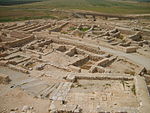Wadi al-Na'am
Arab villages in IsraelBedouin localities in IsraelSociety of the State of Palestine
Wadi al-Na'am is an unrecognized Bedouin village in the Negev desert in southern Israel. The nearest official settlement is Beersheba. The village is home to about 5,000 Negev Bedouins who live mainly in tents and tin shacks less than 500 metres away from a toxic waste dump, largely surrounded by the Ramat Hovav industrial zone and military areas including an Israel Defense Forces live-fire range. Because the village is unrecognized, it is ineligible for basic services and subject to periodic house demolitions, even though the inhabitants hold Israeli citizenship.
Excerpt from the Wikipedia article Wadi al-Na'am (License: CC BY-SA 3.0, Authors).Wadi al-Na'am
40,
Geographical coordinates (GPS) Address Nearby Places Show on map
Geographical coordinates (GPS)
| Latitude | Longitude |
|---|---|
| N 31.163386111111 ° | E 34.822152777778 ° |
Address
40
South District, Israel
Open on Google Maps










